 The attack on the village of Ravno on October 1, 1991, marked a pivotal moment in the history of the war in Bosnia and Herzegovina, as this event symbolically signaled the real beginning of the conflict on Bosnian territory. Although the then-president of the BiH Presidency, Alija Izetbegović, declared that “this is not our war,” the attack on Ravno clearly showed that the war was already present on Bosnian soil, and BiH could not remain neutral in the conflict engulfing the region.
The attack on the village of Ravno on October 1, 1991, marked a pivotal moment in the history of the war in Bosnia and Herzegovina, as this event symbolically signaled the real beginning of the conflict on Bosnian territory. Although the then-president of the BiH Presidency, Alija Izetbegović, declared that “this is not our war,” the attack on Ravno clearly showed that the war was already present on Bosnian soil, and BiH could not remain neutral in the conflict engulfing the region.
From an analytical standpoint, the attack on Ravno carries multiple layers of significance. First, the strategic goal of the Yugoslav People’s Army (JNA) was to create a pathway for the assault on Dubrovnik, and Ravno, a Croatian village in eastern Herzegovina, represented the first line of this campaign. This underscores the broader dimension of the aggression: Bosnia and Herzegovina was not merely a battlefield between domestic factions but also served as a staging ground for an offensive against Croatia. Thus, Ravno became the first casualty of this broader aggression.
Second, the political aspect of this attack reveals the severe inability of the Bosnian leadership at the time to prevent the JNA from using BiH territory for its military objectives. Izetbegović’s statement that it “was not our war” reflects the dissonance in the leadership’s perception of the conflict—while the government in Sarajevo hoped to maintain neutrality, the war was already unfolding, with Ravno serving as a tragic testament to this reality. This indecision accelerated the self-organization of Croats in BiH, who, fearing further aggression, established the Croatian Community of Herceg-Bosna on November 18, 1991.
Third, the attack carried significant demographic and social consequences. The killing of 24 people and the destruction of villages like Ravno left deep scars on the local population. The brutal killing of elderly civilians in Kijev Do, particularly the murder of seven women, further highlights the barbarity of the conflict. These atrocities, coupled with the destruction of entire communities, reinforced the fears of the Croatian people in BiH that their safety depended solely on their own organization and defense.
1. listopada 1991. napadom JNA na hrvatsko selo Ravno (istočna Hercegovina) započeo je rat u BiH. Selo je totalno uništeno, a Hrvati ubijeni. Tom prilikom predsjednik predsjedništva BiH Alija Izetbegović izjavljuje – "zapamtite, ovo nije naš rat".
1/5 pic.twitter.com/T7FLiKJuf4— ⏳ 🦅 _NinjAa_ ✝️ 🇭🇷 (@M_NinjAa) October 1, 2024
In conclusion, the attack on Ravno was not merely an isolated incident but a turning point in understanding the war in both Bosnia and Herzegovina and Croatia. While the Bosnian leadership hesitated to acknowledge the real threats, the Croatian population in BiH recognized the need for self-organization to defend against aggression, leading to the establishment of Herceg-Bosna.